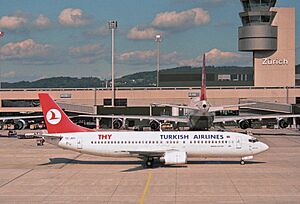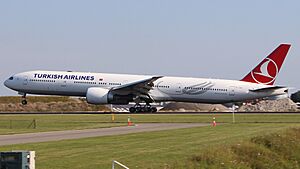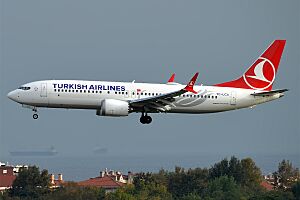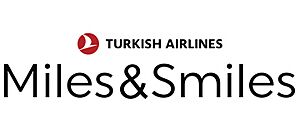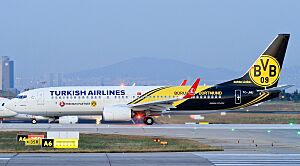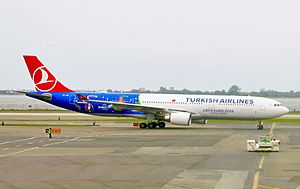Turkish Airlines facts for kids

A Boeing 777-300ER of Turkish Airlines
|
|
| Founded | 20 May 1933 |
|---|---|
| AOC # | TQKF144F |
| Hubs | Istanbul Airport |
| Frequent-flyer program | Miles&Smiles |
| Alliance | Star Alliance |
| Subsidiaries |
|
| Fleet size | 490 |
| Destinations | 352 (incl. cargo) |
| Headquarters | Atatürk Airport Yeşilköy, Istanbul, Turkey |
| Key people |
|
| Revenue | |
| Operating income | |
| Net income | |
| Total assets | |
| Total equity | |
| Employees | 40,264 (2024) |
Turkish Airlines (in Turkish: Türk Hava Yolları) is the main airline of Turkey. It is known as the country's "flag carrier." As of June 2024, it flies to 352 places around the world, including cargo flights. These destinations are in Europe, Asia, Oceania, Africa, and the Americas.
Turkish Airlines serves more countries than any other airline, flying to 131 nations. Its cargo division, Turkish Cargo, uses 24 planes to deliver goods to 82 destinations. The airline also has a budget airline called AJet.
The main office for Turkish Airlines is located at Atatürk Airport in Istanbul. Its main base for flights is Istanbul Airport. Since April 1, 2008, Turkish Airlines has been a part of the Star Alliance, a big group of airlines that work together.
Contents
History of Turkish Airlines
Starting Out
Turkish Airlines began on May 20, 1933. It was first called Turkish State Airlines and was part of the Ministry of National Defense. At first, the airline had only five planes: two Curtiss Kingbirds, two Junkers F 13s, and one Tupolev ANT-9.
In 1935, the airline moved to the Ministry of Public Works and changed its name. Three years later, in 1938, it became part of the Ministry of Transportation.
Growing After the War
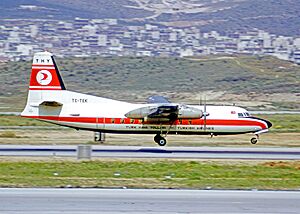
In 1945, Turkish Airlines added several Douglas DC-3s and Douglas C-47s to its fleet. The airline started with domestic flights within Turkey. In 1947, it began flying internationally with a route from Ankara to Istanbul and then to Athens. These new planes helped the airline grow its network.
Soon, flights to Nicosia, Beirut, and Cairo were added. However, flying within Turkey remained the main focus until the early 1960s.
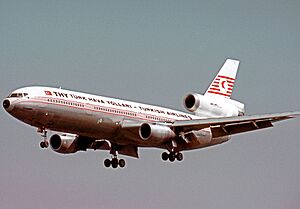
In 1956, the Turkish government changed the airline's name to Türk Hava Yolları A.O. (THY). It also joined the International Air Transport Association (IATA). In 1957, British Overseas Airways Corporation (BOAC) helped with technical support.
New planes like Vickers Viscounts, Fokker F27s, and more Douglas DC-3s joined the fleet in the late 1950s and early 1960s. Turkish Airlines started using its first jet plane, a McDonnell Douglas DC-9, in 1967. More jets, including three Boeing 707s, were added in 1971. In the early 1970s, the airline also started flying McDonnell Douglas DC-10s and Fokker F28s.
The 1980s and 1990s
During the 1980s and 90s, the airline faced some challenges. It was known for delays and not-so-great service. There were also some serious accidents during this time. One notable event was the 1974 crash of Turkish Airlines Flight 981. This accident, caused by a design flaw in the cargo door, led to many deaths. It was a very sad event that highlighted the importance of aircraft safety.
After 1983, a new government saw how important THY was for Turkey. They started to improve the airline, making it more modern. Security became much tighter.
In 1984, THY built a new, advanced technical center at Yeşilköy Airport. This center could perform major repairs on many types of aircraft. By the mid-1980s, THY had 30 planes and flew about three million passengers each year.
Turkish Airlines began using Airbus A310s in 1985, which allowed flights to Singapore in 1986. A route to New York City was added in 1987.
The airline ordered five Airbus A340 planes in 1990 to fly non-stop to North America and East Asia. The first A340 arrived in 1993.
After the Persian Gulf War, the airline struggled but recovered by 1994. Flights to North America grew a lot, and a non-stop flight to New York City started in July 1994.
By 1995, THY had a profit of $6 million. The domestic flight market in Turkey became more open to competition in 1996. THY started working with other international airlines like Japan Airlines, Austrian Airlines, and Swissair to stay competitive. In 1997, THY began flying to Chicago, its second destination in the US.
The 21st Century

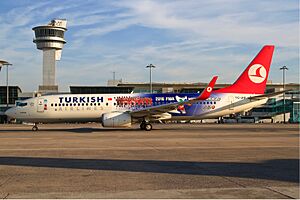
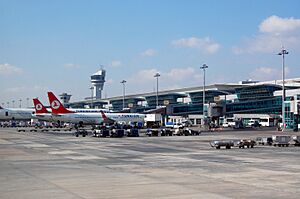
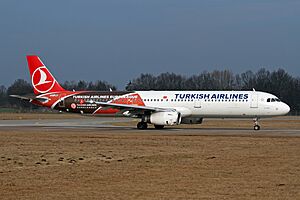
A new terminal opened at Istanbul's Istanbul Atatürk Airport in January 2000. Turkish Airlines continued to expand its international reach. It made agreements with airlines like Asiana Airlines, American Airlines, and Malaysia Airlines.
In 2003, the war in Iraq and the SARS epidemic caused some flight routes to close. However, the airline quickly recovered. It increased flights on existing routes and restarted service to Delhi after 11 years.
A big plan to add more planes started in 2004. This helped THY keep one of the newest fleets in Europe. In July 2004, the airline ordered 36 jets from Airbus and 15 Boeing 737s.
THY also planned to build a new technical and training center at Sabiha Gökçen International Airport. The airline's technical services team, Turkish Technic, grew to maintain not only THY's planes but also those of other airlines.
On April 1, 2008, Turkish Airlines officially joined the Star Alliance. This made it the seventh European airline in this large alliance.
In December 2011, the Turkish government planned to modernize the Aden Adde International Airport in Mogadishu, Somalia. Turkish Airlines became the first international airline to fly to Somalia again in March 2012, after the country's civil war.
By the end of 2013, Turkish Airlines flew to 241 destinations worldwide. This included 199 international and 42 domestic places. The airline also started using Istanbul Sabiha Gökçen International Airport more as a second main hub.
In 2016, Turkish Airlines faced some financial challenges. However, the airline recovered well in 2017, showing a big increase in earnings and returning to profit.
In February 2022, Turkish Cargo moved all its operations to the new Istanbul Airport. In February 2023, Turkish Airlines announced that its low-cost airline, AnadoluJet, would become an independent airline.
Recently, on November 29, 2024, Turkish Airlines started flying to Sydney, Australia. This was its second route to Australia, after Melbourne. On December 18, 2024, the airline announced new flights to Santiago, Chile, and to Benghazi, Libya, starting in January 2025.
How Turkish Airlines Works
The main office of Turkish Airlines is located at Istanbul Atatürk Airport in Yeşilköy, Bakırköy.
Leaders of the Airline
As of January 2022, Ahmet Bolat is the Chairman of the board for Turkish Airlines. Bilal Ekşi is the Deputy Chairman and the Chief Executive Officer (CEO).
Airline Performance Over Time
Turkish Airlines has grown a lot over the years. Here's a quick look at some key numbers:
- In 2003, the airline had a turnover of $2.0 billion and carried 10.4 million passengers. It had 65 aircraft and flew to 103 destinations.
- By 2013, its turnover grew to $8.7 billion, carrying 48.3 million passengers. The fleet had 233 aircraft, flying to 243 destinations.
- In 2023, the turnover reached $20.9 billion, with 83.3 million passengers. The airline had 440 aircraft and flew to 345 destinations.
- The airline has seen its revenue, profit, and number of passengers generally increase over the years, showing strong growth.
Where Turkish Airlines Flies
As of 2024, Turkish Airlines flies to 340 destinations in 129 countries. This includes 53 places within Turkey. In December 2024, Turkish Airlines officially set a Guinness World Record for flying to the most countries, reaching 131.
Working with Other Airlines
Turkish Airlines works with many other airlines through "codeshare agreements." This means they sell tickets on each other's flights, making it easier for passengers to travel to more places. Some of these airlines include:
- Aegean Airlines
- Air Albania
- Air Algérie
- Air Astana
- Air Canada
- Air China
- Air Europa
- Air India
- Air Moldova
- Air New Zealand
- Air Serbia
- Air Seychelles
- airBaltic
- Airlink
- All Nippon Airways
- Asiana Airlines
- Avianca
- Azerbaijan Airlines
- Azul Brazilian Airlines
- Bangkok Airways
- Batik Air Malaysia
- Belavia
- Copa Airlines
- Croatia Airlines
- Egyptair
- Ethiopian Airlines
- Etihad Airways
- EVA Air
- Finnair
- Garuda Indonesia
- Gol Linhas Aéreas Inteligentes
- Gulf Air
- Hawaiian Airlines
- Hong Kong Airlines
- Icelandair
- IndiGo
- ITA Airways
- JetBlue
- KM Malta Airlines
- Kuwait Airways
- LATAM Brasil
- LOT Polish Airlines
- Lufthansa
- Luxair
- Malaysia Airlines
- MIAT Mongolian Airlines
- Middle East Airlines
- Oman Air
- Pakistan International Airlines
- Philippine Airlines
- Royal Air Maroc
- Royal Brunei Airlines
- Royal Jordanian
- RwandAir
- Singapore Airlines
- TAP Air Portugal
- TAROM
- Thai Airways International
- United Airlines
- Utair
- Uzbekistan Airways
- Vietnam Airlines
They also have "interline agreements" with other airlines, which helps with connecting flights:
- Air Transat
- Austrian Airlines
- Drukair
- Emirates
- Loganair
- Swiss International Air Lines
- Virgin Atlantic
Turkish Airlines Fleet
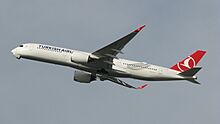
As of May 2024, Turkish Airlines has a fleet of 407 aircraft. They use 13 different types of passenger planes. The airline started with just five planes in 1933. By 1945, it had 52 planes, becoming the largest airline in the Middle East at that time.
The first jet plane, a Douglas DC-9, joined the fleet in 1967. The first large wide-body plane, a Douglas DC-10, was added in 1972. In the late 1980s, the airline started adding Airbus A310s and ordered Airbus A340s. The first Boeing 737 arrived a few years later.
In 2004, the airline ordered over 50 new planes from both Boeing and Airbus. In 2013, they ordered almost 200 more aircraft. In March 2018, they ordered 25 Boeing 787-9s and 25 Airbus A350-900s, which started arriving in 2019 and 2020.
On May 11, 2023, the airline announced plans to buy about 600 new aircraft over the next 10 years. Most of these will be from Airbus and Boeing.
Miles&Smiles: The Frequent-Flyer Program
Miles&Smiles is Turkish Airlines' program for frequent flyers. It started in 2000. Members earn miles when they fly with Turkish Airlines or any airline in the Star Alliance network. These miles can be used for future flights.
- Miles&Smiles Credit Card: People can also earn miles by using a Miles&Smiles credit card for their everyday purchases. These cards are available in countries like Turkey, Israel, Azerbaijan, Germany, Jordan, and the United States.
- Turkish Airlines Corporate Club: This program is for businesses. It helps companies arrange business travel easily and offers special benefits.
Sponsorships and Promotions
Turkish Airlines has been the official airline for many European football clubs. These include famous teams like Galatasaray, Manchester United, FC Barcelona, and Borussia Dortmund.
The airline has also worked with famous athletes and actors for promotions. Some of these stars include Lionel Messi, Kobe Bryant, Caroline Wozniacki, and Kevin Costner.
Since 2010, Turkish Airlines has been the main sponsor of the Turkish Airlines EuroLeague, a top European basketball league. They also sponsored the 2010 FIBA World Championship.
In 2013, Turkish Airlines started sponsoring the Turkish Airlines Open, a golf tournament in Turkey. They have also been a kit sponsor for football clubs like Galatasaray and Trabzonspor.
In December 2015, Turkish Airlines became the first airline to sponsor the UEFA European Championship tournaments, signing a deal for UEFA Euro 2016.
In January 2016, Turkish Airlines partnered with Warner Bros. to sponsor the movie Batman v Superman: Dawn of Justice. A key scene in the movie even takes place on a Turkish Airlines plane.
More recently, in August 2019, Turkish Airlines became the main sponsor for the Argentine sports club Club Atlético River Plate. Before the 2022–23 season, Turkish Airlines also became an official global sponsor of the UEFA Champions League and other UEFA events.
Turkish Airlines Flight Academy
Turkish Airlines Flight Academy (TAFA) was started in 2004 and began training pilots in 2006. The academy is based at Istanbul Atatürk Airport and uses Aydın Çıldır Airport for flight training.
The academy's fleet has 25 aircraft. These include 13 Cessna 172S NAVIII planes, 6 Diamond DA-40 planes, and 6 Diamond DA-42 NG planes.
Turkish Airlines Maintenance Center
Turkish Technic is Turkish Airlines' center for maintaining and repairing aircraft. It was created in 2006. This center takes care of Turkish Airlines' planes and also planes from other airlines. They have eight large hangars for this work.
Turkish Technic can work on aircraft bodies, landing gear, and other parts. In 2010, they opened an engine center with Pratt & Whitney at Sabiha Gökçen International Airport. This center provides engine repair services to customers worldwide.
Turkish Technic has facilities at Istanbul Atatürk Airport and Sabiha Gökçen International Airport. They also have smaller hangars at Ankara Esenboğa Airport. New hangars are being built at the new Istanbul Airport to support the airline's growing fleet.
Safety and Incidents
Like all major airlines, Turkish Airlines has experienced incidents and accidents throughout its long history. Each event is carefully investigated to understand what happened and to improve safety for future flights. These investigations help make air travel safer for everyone.
One significant event was the 1974 crash of Turkish Airlines Flight 981 in France. This accident was caused by a design flaw in the cargo doors of the aircraft type. This tragic event led to important changes in aircraft design and safety rules around the world.
A more recent event was Turkish Airlines Flight 1951 in 2009, which crashed on approach to Amsterdam Airport Schiphol. Investigations showed that a faulty altimeter and crew actions contributed to the accident. This also led to further safety improvements.
Aviation safety is a top priority for airlines and regulators. Every incident provides valuable lessons that help improve aircraft technology, pilot training, and air traffic control procedures, making flying safer over time.
Images for kids
-
A Boeing 777-300ER of Turkish Airlines
-
THY Fokker F27 Friendship landing at Athens Hellenikon Airport in 1973
-
THY Douglas DC-10 in 1974 wearing the airline's initial colour scheme
-
A Boeing 707 operated by Turkish Airlines at Heathrow Airport in 1984
-
Turkish Airlines Boeing 737 at Zurich Airport in 1995
-
A Turkish Airlines Boeing 777-300ER with the FC Barcelona colours in 2012; the airline was the official sponsor and carrier of the club between 2010 and 2013.
-
A Turkish Airlines Boeing 737-800 in 2010 FIBA World Championship livery at Istanbul Atatürk Airport
-
Istanbul Atatürk Airport, November 2013
-
A Turkish Airlines Airbus A321-200 in Turkish Airlines Euroleague livery. The airline has been the primary sponsor of the top European basketball league since 2010.
-
A Turkish Airlines Boeing 777-300ER landing at Amsterdam Schiphol Airport (2020)
-
A Boeing 737 MAX 8 of Turkish Airlines on final approach for Istanbul Atatürk Airport (2018)
-
The Airbus A350 is the newest addition to the fleet (pictured 2021)
-
Turkish Airlines also sponsored Bundesliga club Borussia Dortmund.
-
Turkish Airlines Airbus A330-300, decorated with UEFA Euro 2016 emblems
-
Turkish Airlines Airbus A330-300 with a special UEFA Champions League livery
See also
 In Spanish: Turkish Airlines para niños
In Spanish: Turkish Airlines para niños



